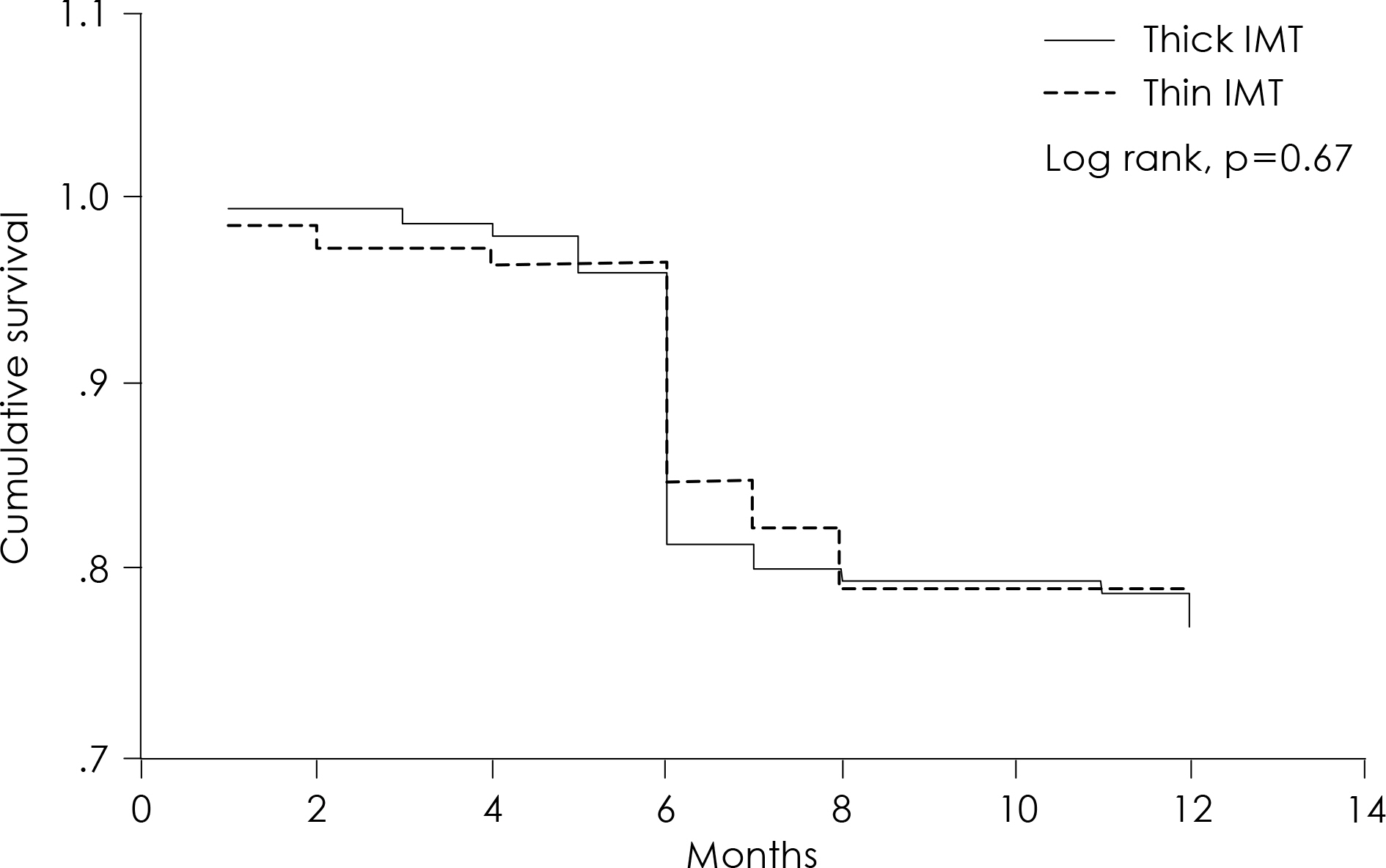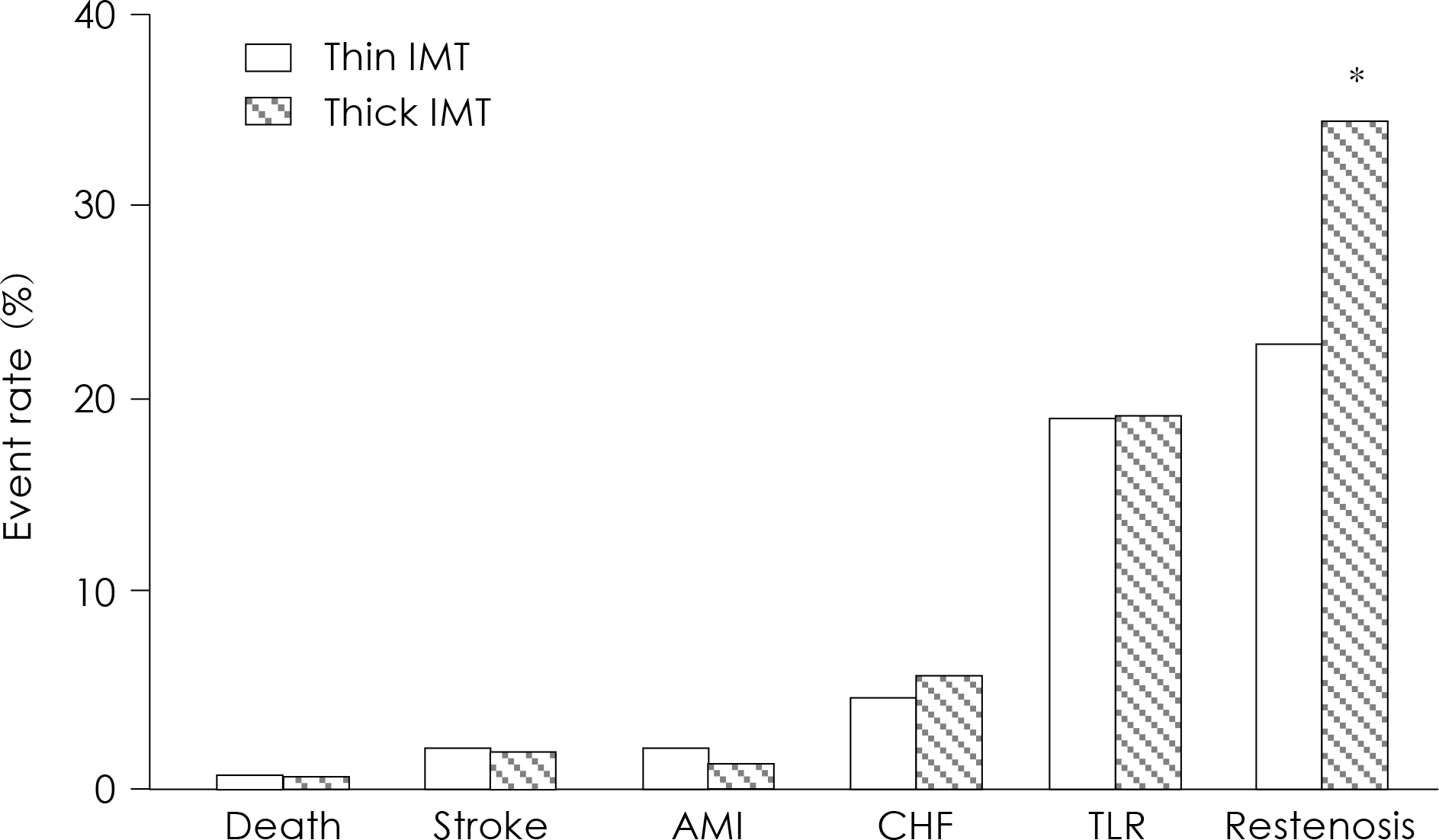Korean Circ J.
2007 Mar;37(3):103-107. 10.4070/kcj.2007.37.3.103.
The Prognostic Significance of Carotid Intima-Media Thickness in Patients Who Underwent Percutaneous Coronary Intervention
- Affiliations
-
- 1Cardiology Division, Heart Center, Konyang University Hospital, Deajeon, Korea. janghobae@yahoo.co.kr
- KMID: 2227080
- DOI: http://doi.org/10.4070/kcj.2007.37.3.103
Abstract
-
BACKGROUND AND OBJECTIVES: Increased carotid intima-media thickness (IMT) is known to be associated with adverse cardiovascular events in the patients with risk factors or established atherosclerosis. However, the prognostic importance of carotid IMT is uncertain in the patients who underwent percutaneous coronary intervention (PCI). We sought to evaluate the association of carotid IMT with major adverse cardiovascular events (MACE) and restenosis in the patients who underwent PCI.
SUBJECTS AND METHODS
The study population consisted of 308 consecutive patients who underwent PCI, and they were followed up for mean of 30.6+/-13.3 months. Base on the median values of carotid IMT, which was measured in the right common carotid artery at the time of PCI with using high-resolution ultrasound and a semiautomatic method, the subjects were divided into the thick (n=156, 1.003+/-0.14 mm) and thin IMT (n=152, 0.748+/-0.07 mm) groups, and they were followed up for at least 1 year.
RESULTS
Patients with thick carotid IMT were older (61+/-9 years vs. 57+/-10 years, respectively, p=0.001), had a higher body mass index (25.0+/-3.0 vs. 23.9+/-4.0, respectively, p=0.017), a history of previous myocardial infarction (20% vs. 9%, respectively, p=0.008), more multivessel disease and more restenosis (34.6% vs. 23.0%, respectively, p=0.025) than those patients with a thin carotid IMT. However other MACEs such as death, myocardial infarction, stroke, heart failure and target lesion revascularization did not show any significant differences between the two groups. Multivariate Cox regression analysis showed that carotid IMT was an independent predictor of restenosis (odds ratio: 1.754, 95% confidence interval: 1.1296 to 2.726, p=0.012).
CONCLUSION
An increased carotid IMT is associated with restenosis, but it does not have clinical prognostic importance for the patients who underwent PCI during a mean follow up period of 31 months.
MeSH Terms
Figure
Reference
-
References
1). Bae JH, Seung KB, Jung HO, et al. Analysis of Korean carotid intima-media thickness in Korean healthy subjects and patients with risk factors: Korea multicenter epidemiological study. Korean Circ J. 2005; 35:513–24.
Article2). O'Leary DH, Polak JF, Kronmal RA, et al. Thickening of the carotid wall: a marker for atherosclerosis in the elderly? Stroke. 1996; 27:224–31.3). Mannami T, Konishi M, Baba S, Nishi N, Terao A. Prevalence of asymptomatic carotid atherosclerotic lesions detected by high-resolution ultrasonography and its relation to cardiovascular risk factors in the general popular of a Japanese city: the Suita study. Stroke. 1997; 28:518–25.4). Jeong IB, Kim KY, Bae JH, et al. The carotid intima-media thickness as a screening test for coronary artery disease. Korean Circ J. 2005; 35:460–6.
Article5). Burke GL, Evans GW, Riley WA, et al. Arterial wall thickness is associated with prevalent cardiovascular disease in middle-aged adults: the Atherosclerosis Risk in Communities(ARIC) study. Stroke. 1995; 26:386–91.6). Crouse JR, Goldbourt U, Evans G, et al. Risk factors and segment-specific carotid arterial enlargement in the Atherosclerosis Risk in Communities(ARIC) cohort. Stroke. 1996; 27:69–75.7). Tonstad S, Joakimsen O, Stensland-Bugge E, et al. Risk factors related to carotid intima-media thickness and plaque in children with familial hypercholesterolemia and control subjects. Arterioscler Thromb Vasc Biol. 1996; 16:984–91.
Article8). Davis PH, Dawson JD, Riley WA, Lauer RM. Carotid intimal-medial thickness is related to cardiovascular risk factors measured from childhood through middle age: the Muscatine Study. Circulation. 2001; 104:2815–9.9). Park KR, Kim KY, Yoon SM, Bae JH, Seong IW. Correlation between intima-media thickness in carotid artery and the extent of coronary atherosclerosis. Korean Circ J. 2003; 33:401–8.
Article10). Grobbee DE, Bots ML. Carotid artery intima-media thickness as an indicator of generalized atherosclerosis. J Intern Med. 1994; 236:567–73.
Article11). Hulthe J, Wikstrand J, Emanuelsson H, Wiklund O, de Feyter PJ, Wendelhag I. Atherosclerotic changes in the carotid artery bulb as measured by B-mode ultrasound are associated with the extent of coronary atherosclerosis. Stroke. 1997; 28:1189–94.
Article12). Pignoli P, Tremoli E, Poli A, Oreste P, Paoletti R. Intimal plus medial thickness of the arterial wall: a direct measurement with ultrasound imaging. Circulation. 1986; 74:1399–406.
Article13). O'Leary DH, Polak JF, Kronmal RA, Manolio TA, Burke GL, Wolfson SK Jr. Carotid-artery intima and media thickness as a risk factor for myocardial infarction and stroke in older adults. N Engl J Med. 1999; 340:14–22.14). Kieltyka L, Urbina EM, Tang R, Bond MG, Srinivasan SR, Berenson GS. Framingham risk score is related to carotid artery intima-media thickness in both white and black young adults: the Bogalusa Heart Study. Atherosclerosis. 2003; 170:125–30.
Article15). Barth JD. Which tools are in your cardiac workshop?: carotid ultrasound, endothelial function, and magnetic resonance imaging. Am J Cardiol. 2001; 87:8A–14A.
Article16). Hodis HN, Mack WJ, LaBree L, et al. The role of carotid intima-media thickness in predicting clinical coronary event. Ann Intern Med. 1998; 128:262–9.17). Crouse JR 3rd, Byington RP, Bond MG, et al. Pravastatin, lipids, and atherosclerosis in the carotid arteries(PLAC-II). Am J Cardiol. 1995; 75:455–9.18). Hodis HN, Mack WJ, LaBree L, et al. Reduction in carotid arterial wall thickness using lovastatin and dietary therapy. Ann Intern Med. 1996; 124:548–56.
Article19). McMahon S, Sharpe N, Gamble G, et al. Effects of lowering average or below average cholesterol levels on the progression of carotid atherosclerosis: results of the LIPID Atherosclerosis Substudy. Circulation. 1998; 97:1784–90.20). Taylor AJ, Kent SM, Flaherty PJ, Coyle LC, Markwood TT, Ver-nalis MN. ARBITER: Arterial Biology for the Investigation of the Treatment Effects of Reducing Cholesterol: a randomized clinical trial comparing the effects of atorvastatin and pravastatin on carotid intima medial thickness. Circulation. 2002; 106:2055–60.21). Taylor AJ, Sullenberger LE, Lee HJ, Lee JK, Grace KA. Arterial Biology for the Investigation of the Treatment Effects of Reducing Cholesterol(ARBITER) 2: a double-blind, placebo-controlled study of extended-release niacin on atherosclerosis progression in secondary prevention patients treated with statins. Circulation. 2004; 110:3512–7.22). Pitt B, Byington RP, Furberg CD, et al. Effect of amlodipine on the progression of atherosclerosis and the occurrence of clinical events. Circulation. 2000; 102:1503–10.
Article23). Rajagopal V, Rockson S. Coronary restenosis: a review of mechanisms and management. Am J Med. 2003; 115:547–53.
Article24). Buffon A, Liuzzo G, Biasucci LM, et al. Preprocedural serum levels of C-reactive protein predict early complications and late restenosis after coronary angioplasty. J Am Coll Cardiol. 1999; 34:1512–21.
Article25). Hojo Y, Ikeda U, Katsuki T, et al. Interleukin 6 expression in coronary circulation after coronary angioplasty as a risk factor for restenosis. Heart. 2000; 84:83–7.
Article26). Amar J, Fauvel J, Drouet L, et al. Interleukin 6 is associated with subclinical atherosclerosis: a link with soluble intercellular adhesion molecule 1. J Hypertens. 2006; 24:1083–8.
Article27). Sander D, Schulze-Horn C, Bickel H, Gnahn H, Bartels E, Conrad B. Combined effects of hemoglobin A1c and C-reactive protein on the progression of subclinical carotid atherosclerosis. Stroke. 2006; 37:351–7.28). Elkind MS, Rundek T, Sciacca RR, et al. Interleukin-2 levels are associated with carotid artery intima-media thickness. Atherosclerosis. 2005; 180:181–7.
Article
- Full Text Links
- Actions
-
Cited
- CITED
-
- Close
- Share
- Similar articles
-
- Carotid ultrasound in patients with coronary artery disease
- Measurements of Carotid Intima, Media, and Intima-media Thickness and Their Clinical Importance
- Do we need individual measurement of carotid intima and media thickness?
- Response: Increased Carotid Intima-Media Thickness Is Associated with Progression of Diabetic Nephropathy in Patients with Type 2 Diabetes
- The Relationship between Metabolic Syndrome and Intima-media Thickness of the Common Carotid Artery (IMT-CCA) in Young Adult Men



